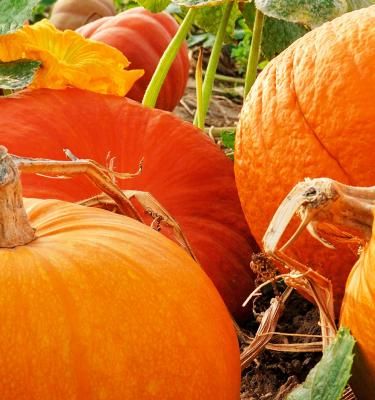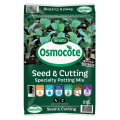

The Ultimate Guide to Growing Pumpkins
Delicious in pies, soups and stews and full of vitamins and minerals, pumpkins are a tasty autumn and winter treat. Follow our simple guide to growing pumpkins for a bumper harvest.
Pumpkin growing season in Australia
Plant pumpkins in mid spring in temperate climates. In cool climates, plant pumpkins in late spring.
Harvest pumpkins in Autumn (February-March) in all climates.
Choosing the best pumpkins to grow
Pumpkins (Cucurbita pepo) belong to the same family as squash, zucchini and cucumbers. There's a wide range of different pumpkins available, from the huge 'Dill's Atlantic Giant', which can produce fruits weighing several hundred kilograms to the tiny 'Jack Be Little' which bears miniature pumpkins just 7cm across. Not all make great eating – the giant types are grown mainly for weight competitions and have very little flavour while the smallest are terrific table decorations as well as being sweet tasting.
Most pumpkins need space because they will cover a lot of ground but if you don't have a big garden, you can grow smaller varieties as climbers. And if you want a change from the traditional orange-skinned pumpkin, there are pumpkins with striped, knobbly or pleated skins and even white or blue pumpkins. It's safe to say, there's a pumpkin for every taste! There are dozens of different types, many of which are only available from heirloom or specialist seed suppliers.
In Australia, the main pumpkin types grown are:
- Butternut – elongated, pale-skinned with smooth flesh
- Queensland Blue – with rich orange flesh, it’s popular for boiling, steaming, baking and scone! Stores well.
- Kent – dark green, often with gold stripes that’s a great cooking variety as well as good for soups
- Jarrahdale – grey-green skin, large, ribbed pumpkins and good flavour, keeps well. Top-selling commercial variety.

Essential shopping list for growing pumpkins
Here's what you'll need for growing perfect pumpkins in your garden.
For growing pumpkins from seed:
- 9cm pots
- Seed Raising Mix
- Labels
For growing pumpkins in the ground:
- Compost and soil improver or well weathered manure
- Spade
- Roof tiles or concrete pavers
For growing pumpkins vertically as climbers:
- Wooden poles or sturdy bamboo canes around 2m long
- String
Growing pumpkins from seed
To grow pumpkin from seed, sow pumpkin seeds in seed trays or pots in early spring (September) early in the year, in mid to late April, as the plants have a long growing season.
- Fill individual 9cm pots with Seed Raising Mix.
- Plant the seeds 2.5cm deep, on their sides.
- Water the pots and place them in a warm spot indoors or sheltered veranda. The seeds should germinate in around five to seven days.
- After germination, place the pots on a sunny windowsill or veranda until the seedlings are large enough to be planted out.
Pumpkin seeds may also be sown direct where the plants are to be grown. Form mounds of soil or compost about 2m apart and sow 2-3 seeds in each, removing all but the strongest after germination. Wait until the soil has started to warm in spring before direct seeding.
How to plant pumpkins
Planning when to plant pumpkins depends on the weather. Pumpkins won't grow in the cold, so wait until mid spring before planting them in a sunny position.
A few weeks before planting, create planting pockets by digging a hole for each plant, approximately 20cm square x 20cm deep. Allow 2m between plants and between rows.
Fill each hole with compost or well-weathered manure. Pumpkins are voracious feeders and need a rich, fertile soil to produce good fruits.
To grow pumpkins vertically, you'll need to train them as climbers. Drive three sturdy poles firmly into the ground around a planting pocket and tie them together at the top to create a tripod to support the plants. Make sure the structure is strong, as even small pumpkin plants can weigh a lot by harvest time. Allow 1m between climber-grown pumpkin plants.
Plant one seedling in each planting pocket. Firm the soil around the plant and water well.
Tips for pumpkin growing & care
Caring for your pumpkins as they grow is essential. Water plants thoroughly once a week. In hot, dry weather, increase this to twice a week. Always water the soil, not the leaves, to minimise the risk of fungal diseases.
If you're growing pumpkins as climbers, tie the trailing stems to the support poles as they grow.
When fruits start to develop, feed the plants fortnightly with a high potash liquid plant food. Slide a roof tile or concrete paver under each pumpkin to keep them off damp ground and protect them from slugs and rot. Pumpkin plants will usually produce two to three fruits per plant, although the smaller varieties can produce more.
When to pick pumpkins in Australia & how to harvest them
- Leave the fruits to ripen on the plants for as long as possible for the best flavour. If there's a risk of early frosts, protect the pumpkins with cardboard and straw.
- To judge when to harvest pumpkins, knock gently on the fruits. If they sound hollow, they're ready to harvest.
- Use secateurs to cut pumpkins off the vine, leaving a long stalk on the fruit.
- Before storing pumpkins, first cure the skins by leaving the fruits out in the sun for around 10 days. In poor weather, place them on a sunny veranda or patio under cover.
- Once the skins have cured, store the pumpkins in a well-ventilated, cool place at a temperature of around 7-10°C. Check periodically for any signs of rot and remove any affected fruits. Stored pumpkins can last for up to six months.
Pumpkin pests, diseases & problems
Pumpkins can be affected by powdery mildew, a fungal disease that causes white powdery markings on the leaves and, in severe cases, can stunt the plants' growth. Drought makes plants more susceptible to powdery mildew, so reduce the risk of infection by watering regularly. Avoid wetting leaves when watering. Remove and dispose of any affected leaves as soon as you see them.
In cool weather, fruits sometimes fail to develop or drop off the plant while small. This is due to the flowers not being pollinated. Once the weather warms up, the problem usually resolves.
Occasionally fruit set may be poor due to a lack of pollinating insects. Hand pollination using a small paint brush to transfer pollen from male flowers to female flowers will assist in improving the number of pumpkins that will develop.



